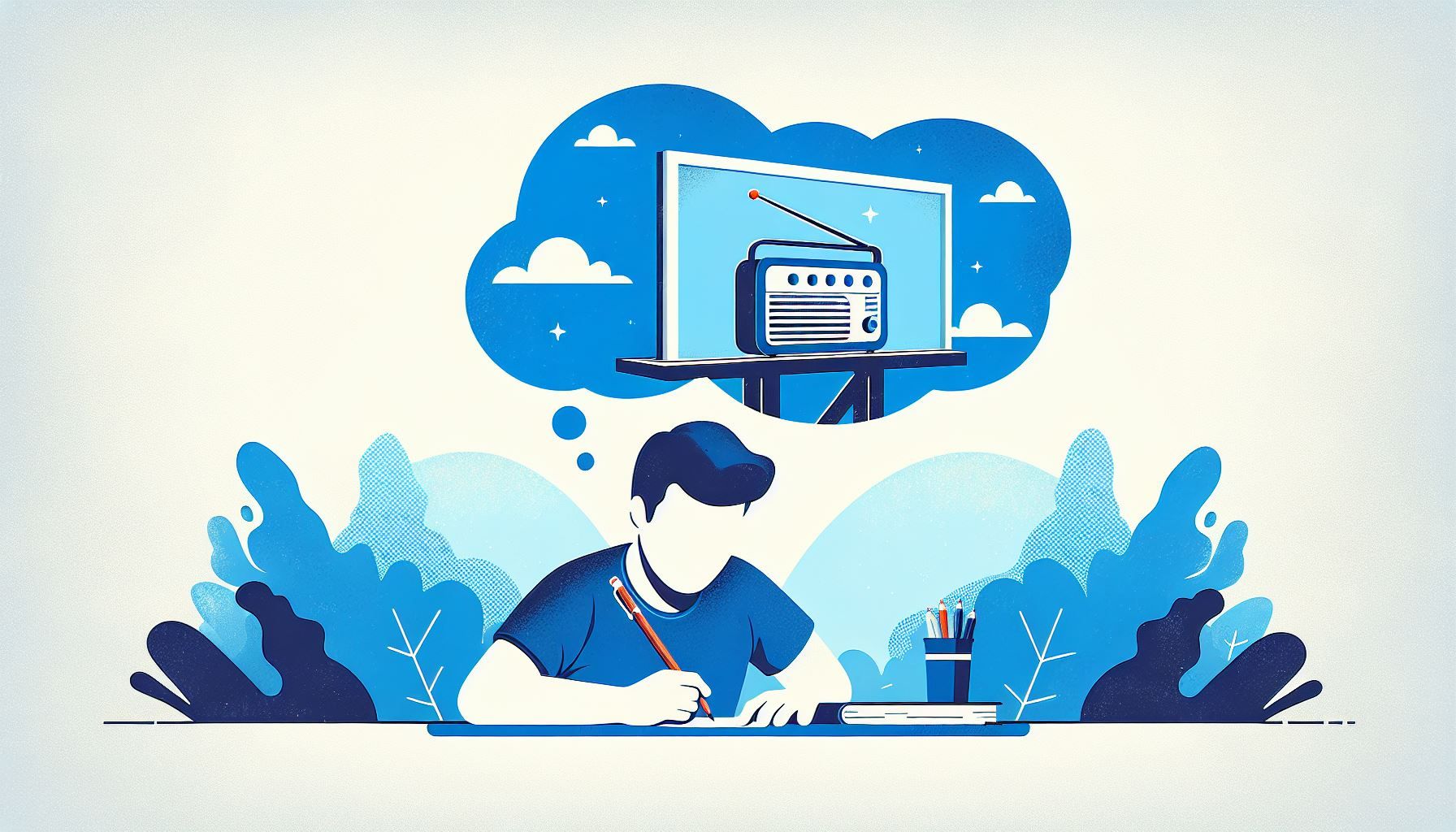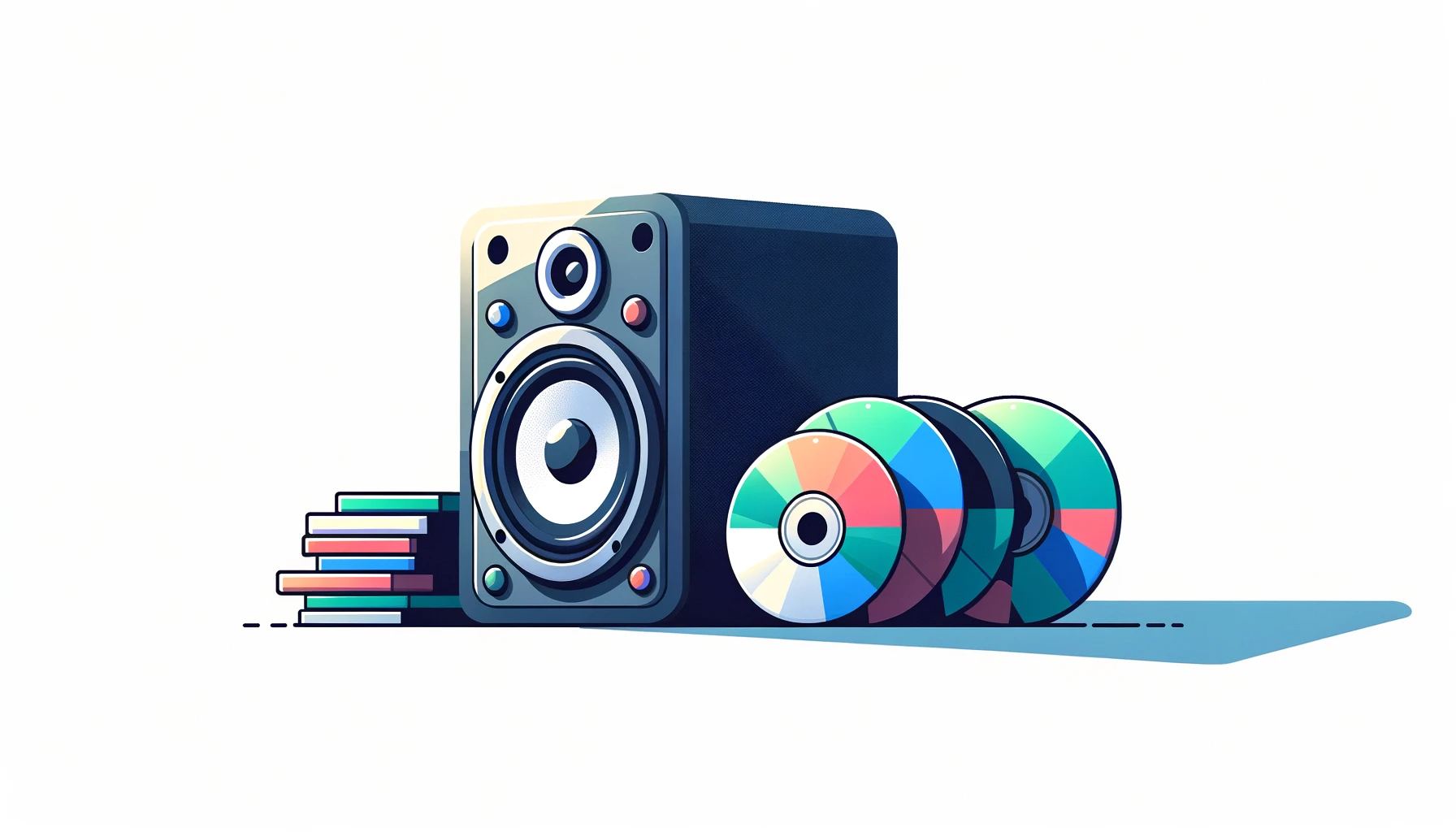Write Great Radio Ads: The Ultimate Guide
How are you trying to write a radio ad? \"Clap! Clap!\" Those two claps were for you. And more great information is inside this article ready for your picking

Today, I’m going to show you how to write radio ads. It doesn’t matter if you’re an absolute beginner, together we’ll learn:
- The basics of radio ads.
- Ad scripting techniques.
- How radio ads are produced.
- Mistakes not to make in your radio ads.
- Tips for writing great radio advertisements.
- And more!
There is no magic spell to wish your writing troubles away. But this article comes pretty close…
Part 1: What are radio ads?
A radio ad is an audio announcement promoting a product, service, brand, or event.
It’s also called an ad spot or spot in short.
Radio ads are meant to be powerful motivators that encourage listeners to carry out a particular action.
And they are very different from the visual ads you see on TV or YouTube.
Ten Features of Radio Ads
1. Radio ads can be live or pre-recorded
The presenter, station announcer, or newscaster may choose to read out a live commercial on air.
The presenter may have a prepared script or naturally incorporate the promotional message as part of the general broadcast. This can be during the spoken segments of shows, such as the links in-between songs.
On the other hand:
Pre-recorded commercials have undergone prior production, including recording, editing, mixing, adding sound effects, etc.
This can be done in-house by the station’s staff or outsourced to an agency.
2. Radio ads are 30s to 60s long
Most radio ads are 30 or 60 seconds long. But some radio spots are 15s, 10s or 5s long.
So how many words are in a 30-second ad? Easy, just refer to this table:
| No of words | Seconds |
|---|---|
| 25 | 10 |
| 35 | 15 |
| 40-75 | 30 |
| 125-140 | 60 |
3. They have a call to action (CTA)
All radio ads have a call to action. Basically, in the CTA, you tell the listener what to do after listening to the ad.
“Call us now at 800-555-1212 to order yummy pizzas at 50% off.”
“Go to www.puppies.com, sign up, and receive your free subscription to Puppy Toys Magazine.”
4. Heavily dependent on quality copy
Radio ads— the pre-recorded bits in particular — must be expertly written, creative, and funny.
It’s essential to tell stories and create a strong connection with the listener.
So:
Cultivate the skill to effectively use words to rouse emotions and inspire the listener to action. Get started with these 600+ words to infuse your copy with emotions.
5. Consists of sound effects, music beds, etc.
Sound effects and music beds help build an atmosphere, create realism, and trigger memories & emotions.
Let’s say you are promoting a cure for a terrible headache…
Your idea is to do a traffic jam skit. You will need sound effects such as honking cars, shouting motorists, etc.
Listeners will be reminded of the terrible headaches that emerge when stuck in a traffic jam.
You can use jubilant sound effects as you introduce the solution to the headaches plaguing your listeners.
6. Radio ads are inexpensive to produce and run
Radio ads are cost-effective, from production to paying for the airtime. It makes them appealing to small businesses & professionals.
7. Dayparts may influence the cost of running a radio ad
The price of radio airtime varies depending on the time of day.
The most premium spots are usually in the morning. Most listeners tune in for the morning or AM drive show that starts from 6:00 am to 10:00 am.
Midday and afternoon drive dayparts are also considered “Prime.”
During the evenings, fewer people may be listening to the radio, and 30-second spots may cost less than in prime times.
Part 2: How are Radio Ads Produced
So what’s the process of creating a radio ad?
It depends on how the business wants to go about it. There are two ways really.
One, the business could seek the help of a radio advertising agency. The agency will work with the client to create & distribute the ad.
Alternatively, the client could engage the station directly. The radio station, in this case, might have a team of in-house copywriters or have connections with freelance radio copywriters.
They will also find the talent and assign a producer to work on the ad.
Next, they will source and add all the background music, sound effects, etc.
The finished radio ad will then get slotted into the normal programming by the program director. The number of times the ad runs will be tracked and invoices are sent to the client.
Radio Ad Production Techniques
1. Straight announcer
The straight announcer is the single voice of the ad. They read the entire script. So here, you need a clear strong voice that engages the listeners.
Example:
2. Two announcer/Two-actors
Having two voices or characters in your radio ad opens more creative avenues.
The characters in the ad can have an every-day conversation.
One person can speak about their problem, and the second character can provide a solution that’s based on the product or service being advertised.
If the conversation is taking place between two presenters in the studio, one person can share a personal experience on how the service or product helped them.
Friendly banter is also acceptable.
Here is an example of a radio advertisement performed by two voice actors.
3. Slice of Life
“Slice of life” is a great sounding phrase for a very effective radio advertising technique.
How do you pull this off?
Show a real-life problem. Then give its solution.
Does it sound complex?
Worry not, it gets simple when we break this process into four stages.
Example 1: Advert For An Air Emergency Rescue Service.
Characters:
- Injured person (person one)
- Hero (person two)
- Voice Over
Step 1. Setup/encounter
Someone is running along a tranquil forest trail. You hear soft thuds on the wet ground, chipping birds, and the unison of singing crickets & cicadas.
Step 2. Problem/disaster
Our subject trips on a fallen branch and fractures his ankle. You hear his body smacking the ground. A cracking bone, perhaps followed by wailing or shouts for help.
Step 3. Interaction
Shortly, a fellow lad comes lopping along. He stops by the fallen chap and promises everything will be okay.
Dialogue:
Person One (Injured Lad): Help, help…my leg is fractured!
Person Two: Don’t move, relax, I’ll find you help, mate.
Person One: Please don’t leave me, I am in pain!
Person Two: I’m here mate. Let me just dial for help. (We can hear our hero dialing a number).
Step 4. Solution
Voice Over: We’ll come to you no matter how far you are, be it night or day. EMS, the best emergency evacuation.
We then hear the roar of a copter’s engines as the metal bird swooshes over the dense canopy above.
Person Two: (To the injured lad ): Everything is going to be okay.
Another way is to have two people having a normal conversation. It’s simple as:
Example 2: Get a Life - Date a Lunch App
Jane: What happened to the guy from that app?
Mary: Can’t talk about it…I’m only landing duds.
Jane: Have you tried the Date a Lunch App.
Mary: Another dating app, gosh no!
Jane: Trust me, it’s different. Did you know that the best way to land a good guy is to share food with them?
V.O: No lies! Get the Date a Lunch App from Google Play or App Store. Find love with your stomach.
And write your radio ad like a real conversation.
4. Jingle-announcer
Now here is the truth about jingles.
They are as sticky as glue.
Once you hear a nicely sung jingle, it becomes an incessant earworm.
It’s like having a broken radio playing the same song over and over. Only, you can’t turn it off because it is inside your head.
So as you wake up…jingle.
Brush your teeth…you’re humming the jingle.
Slump down after a long day at the job…jingle.
That’s why the jingle-announcer technique is popular. In this form, the announcer reads part of the copy. And usually at the end, the sung jingle is played.
Here is a terrific specimen that exemplifies this technique:
5. Customer interview (Person on the street)
Are you assaulted by hundreds of ads every day?
You see them everywhere: billboards, on TV, YouTube, Websites, clothes, etc.
Some people have grown immune to ads, not seeing them nor hearing their message. Inattention blindness.
So it’s really important as the radio ad writer to understand this.
Let’s ask:
How can your radio script break up the defenses built up by too much advertising?
Well, let the person on the street (someone who has engaged with the brand before) heap the praise. Let an actual person, not an actor testify about the product.
It could pan out like this:
Radio Ad Example 3: Ramen Burger – Man on the street feature
(In the background, we hear sounds from a busy buzzing city. People walking, cars honking, etc).
Interviewer: Who serves the best burgers in NY?
First respondent: Ramen Burgers definitely.
Interviewer: Which burger would you die for?
Second respondent: The Big Cheese Delight.
Interviewer: From?
Second respondent: Ramen Burgers 14th Street.
Interviewer: Folks. You heard it straight from the public’s mouth. And you can get free delivery with a special discount of the great tasting Ramen Burgers at just $5.99. Call xxx-xxx-xxx.
Writer’s Note: I’m unsure if a busy New Yorker can lend their precious time for the person on the street feature.
Good thing… this is just an example.
Alternatively…
You can also call customers and record their interactions with their permission of course. You can merge these bits into a powerful radio ad.
6. Write a story
This can be a fictitious story pertaining to whatever you’re promoting. Stories, fundamentally, must feature a problem, crisis, and resolution. In this case, the product or service should save the day.
Remember to include these key components:
• Setting (Time and place where the action is happening) • Characters (Who is involved) • Conflict and resolution
Stories can also be told by real-life people about their experiences:
Part 3: Mistakes to Avoid in Your Radio Ad
Superheroes need villains.
For this reason…
Some mistakes can ruin your radio ads.
So, avoid these pitfalls:
1. Making the ad about your business
Does a listener care if your company makes payroll or not?
“No!”
Ouch
Get it from here, the populace has a myriad of problems on hand. Bulging cost of living, inept politicians, costly insurance premiums, climate change, and the human condition, in general.
So when afforded the opportunity to speak to people, address their problems. Make ads about them.
Do ask: “I’m I part of the solution or is my radio advertisement indistinguishable from the typical advertisement fluff!”
I reckon businesses exist to solve problems, right?
2. Being too technical (Too rational)
The apologetic truth about us humans is that most of our decisions don’t have a rational basis.
For instance, have you — when you ought to be striving towards a deadline,— done the opposite? Say, watching a TV series or movie, lazing around and doing everything last minute.
OR:
Consuming foods not for their nutritional value but for their taste and how good they make you feel. I’m talking about french fries cooked in beef tallow.
Cast your eye to the political arena, will you?
Do people elect candidates based on the quality of their manifesto?
The point is:
In your radio ad, don’t lean heavily on the techspeak. Discuss fewer features and more benefits. Focus more on which problems the product solves and how it makes the consumer feel.
I bet you’ve never seen a car advertisement where they list:
- The engine’s specs.
- Rim sizes.
- The exhaust’s diameter.
It’s always grand statements like, “Sheer driving pleasure - BMW or Ferrari - Only those who dare, truly live.”
Car ads may feature an icon emerging from the car in dark gold-rim glasses.
Now here is the question: Is it rational to have fashion models advertising cars but not professional drivers?
Well, effective ads engage the irrational part of the brain. So, what is your radio ad speaking to? The rational mind or the reptilian brain?
3. Not having a goal
The client might tell you:
“Champ, I want this ad to make my car washing business popular.”
Great, that’s a generic goal.
Tell them they need to be specific.
An informed client will say:
“I want to spend $500 on this ad and in return, I want to bring in $2,000 in new business.”
Now, we’re talking.
Have specific goals.
Another helpful thing you should learn is about the types of customers out there…We have:
- Potential customers
- Discount/price customers
- Loyal customers
- Impulsive customers
- Relationship buyers
- Value buyers – who want the most value
So who are you speaking to?
4. Multiple messages
“We are a great family-owned and operated restaurant. Visit us at 340 Southside Ave for the best Chicken Parmigiana, Cheese Ravioli, Roasted Pork Lion, Veal Sicilian, Shrimp Fra Diavolo, Stuffed Mushrooms, Rice Balls. Etc. Etc.”
The lesson here, focus on one thing.
One message.
Something that the listeners are bound to remember.
With that, let’s jump to the last segment of this guide.
Part 4: Tips on How to Write Great Radio Ads
Here is the part of the guide that gives you great tips.
They will make your radio ads effective.
So gear up:
1. Write an award-winning script
You’ll need a great script. Now, if you can’t write the best radio copy, you can hire the right person to make your radio ad a success.
Look for a copywriter with a dash of talent, a flair for words, an imaginative mind, and a devotion to producing results.
You don’t need flowery prose. This ain’t poetry.
It doesn’t need a ton of imagination. Read a novel later.
You need results. And don’t be tight with your coffers.
Spend coin on a valuable radio copywriter. It’s worth it.
“Will you be writing the ad yourself?”
Well, that is the point of this whole guide.
And here are five more tips for you:
1. Study some of the greatest radio ads.
2. Write your ad incorporating the tips in this guide.
3. Rewrite, rewrite, and rewrite.
4. Be open to criticism. It’s leveled against your copy. Nothing personal.
5. Be patient. Your first words will not be gold.
2. Keep it simple
You have 30 or 60 seconds.
So, there is no room for extraneous information.
Go in with your main message.
State the problem.
Show your solution.
And get out.
3. Close like a champ
The last words…
Clearly, we remember them best.
Say a thousand things to me, and I’ll probably remember what you said last.
There is a lot of attention placed on the endings of TV ads, especially. For instance, take this ending from AirTransat’s 30 second TV Ad, “AirTransat. Vacation is calling.”
Another Coca Cola Commercial ended, “Coca Cola. Drink up!”
A Nike ad closed with the words, “It is up to you.”
See, the end matters. So pour your heart into it.
“CloudRadio. We are web radio.”
4. Use vivid language
How can you achieve this?
Easy…
-
Use words with a sensory appeal. For instance, describe taste using words like creamy, delicious, flavorful, bitter, etc. For sight, use words like bright, dull, dim, colorful, etc.
-
Use figurative language – Figures of speech such as similes, metaphors, idioms, personifications, oxymoron, paradox, irony, etc.
-
Comparisons – You can compare two things to paint a clear image. For instance: “The apple is bigger than the strawberry but slightly smaller than a mango.”
-
Concrete nouns – These are nouns that can be physically experienced through the five senses. You can see, touch, smell, taste, and hear them. The opposite is abstract nouns that can’t be perceived by the senses.
5. Build rapport
Use the words “YOUR” and “YOU” as much as possible.
You might be coming from a formal writing background. Many people have been cautioned against using personal pronouns or “you” to refer to the reader.
But this is selling.
There is a human connection that needs to be established. So be relatable. Talk directly to your listeners.
Tell me, which sounds better & warm?
“You’ll save money on this deal.”
Versus.
“Save money on this deal.”
6. Motivate action
So how do you inspire listeners to do your bidding?
There are several ways to tackle this:
-
Appeal to emotions by creating an emotional response
-
Give someone a reason for doing what you’re asking
-
Use stories
-
Get people to do what you want by appealing to their values. (morals, ethics, and so on)
-
Want to inspire change? Be the change first. For instance, does your brand donate a part of the profits it makes on each purchase towards a good cause? Read about Toms Shoes’ inspiring approach to business.
-
Don’t ask for the moon. People will shy away from resource-intensive deeds. So, make it nearly effortless.
For instance, changing the world is a big undertaking. Just ask the listener to turn off the lights earlier than they do in the morning. That’s painless.
7. Problem – solution – incentive – CTA
Here is a simple straightforward formula you can use.
State the problem:
“Are you struggling to find a nice apartment to buy in the city? Tired of dealing with unreliable agents, and paying through the nose for guided tours.”
Solution:
“RentGuides allows you to access buildings for self-guided tours without appointments.”
CTA:
“To begin your next search, register now at rentguides.com”
Incentive:
“And did we mention it’s free?”
8. Introduction + say what you can do for me
“Hey, we are CloudRadio, and here is what our platform can do for you:
- Ensure that your radio stream is very reliable
- Simplify online radio management
- Cut down what you pay for your radio hosting
So go to cloudradio.com.”
9. It doesn’t hurt to make your listener, laugh
Have you shared a laugh with someone of late? How did it make you feel?
Connected, understood, warm?
Some ads are hits because they make the listener laugh.
Funny videos and clips also catch and sustain attention with ease.
And we like sharing laughter. If your ad makes someone laugh, they will want to spread the joy.
It’ll brighten up someone’s day while still passing your message across.
Though there is a caution when it comes to humor. You can be drawn to just writing a funny ad instead of focusing on the core message.
10. Name, problem, solution
Who are you?
“Hi, I’m Jerry McQueen, attorney at law.”
State the problem
“Have you been wrongfully discharged by your employer?”
Go deeper
“But Jerry, you might say, I didn’t read the 50-page contract agreement. How should I know if they wronged me?”
How you can help? What you’re selling?
“Do yourself a huge favor and let us discuss that in person.”
“It’s Jerry McQueen attorney at law, a strong shoulder you can stand on!”
How to write radio ads: send off!
It was a great article to write.
Exhausting, but worth it.
Hopefully, you’ll take away some great tips and apply them to your radio ad copy.
Some of the tips to always remember; focus on the problem, offer the solution, and be relatable.
Be compassionate to your listeners. They should not be victims of bad advertising!


